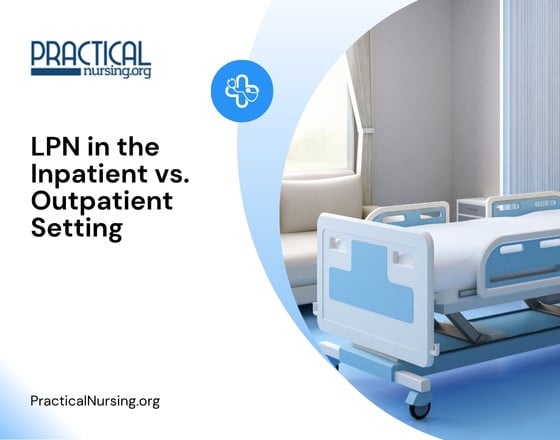LPN in the Inpatient vs. Outpatient Setting


 Licensed Practical Nurses (LPNs) are a valuable member of the healthcare team and can work in a variety of settings. Some work in hospitals, some in clinics, some in nursing homes, and some in schools. Years ago, LPNs worked in emergency rooms and ICUs. They performed many duties including managing drips (under the supervision of an RN).
Licensed Practical Nurses (LPNs) are a valuable member of the healthcare team and can work in a variety of settings. Some work in hospitals, some in clinics, some in nursing homes, and some in schools. Years ago, LPNs worked in emergency rooms and ICUs. They performed many duties including managing drips (under the supervision of an RN).
Today, LPNs are more commonly seen in outpatient settings. There are several reasons for this. Many hospitals now are striving to obtain “magnet status”, which refers to American Nurses Credentialing Center’s Magnet Recognition Program. In a nutshell, achieving magnet status is a high level of honor for hospitals. It demonstrates that the hospital has the capacity to attract and retain quality nurses, which leads to improved patient care outcomes. Because magnet status recognizes hospitals for nursing excellence and leadership, hospitals tend to support and RN-only care model. In today’s’ competitive world of health care, more and more hospitals are vying for magnet status, and thus LPNs are no longer as prominent in inpatient settings.
Another reason why LPNs in the inpatient setting are diminishing is due to patient ratio laws. Before individual state laws were passed restricting the number of patients an RN is assigned, team nursing was prevalent. In this care model, a set of patients were assigned to an RN, LPN and CNA team. Each would be responsible for different nursing care tasks. Because the work was divided among the distinct roles, the team were usually assigned a large number of patients. Not so long ago, a nursing care team could have up to twenty patients! However, studies have proven that the lower the nurse-to-patient ratio, the better the patient care outcomes. Because of this, registered nurses fought for ratio laws and in some states, won.
RELATED: LPN vs RN and LPN vs CNA
While this was a massive win for patient safety, many hospitals chose to switch from team nursing to primary nursing. Rather than have a team manage many patients, one RN would independently manage a handful of patients (depending on the unit). This not only improved patient care outcomes but was more cost-effective for the organization. Unfortunately, this resulted in the displacement of LPNs from the hospital to the outpatient setting.
The reverse happened in the outpatient setting. More LPNs are needed in clinics and schools than RNs, and ratio laws do not apply to clinics. Since the outpatient setting does not usually accommodate acutely ill patients, most of the nursing care can be performed by LPNs. RNs are still needed to provide supervision, but not as many as in the hospital setting.
While the pendulum has swung for LPNs to a more prevalent outpatient setting, any nurse who has been practicing for a long time will tell you everything is cyclic. Healthcare is constantly changing, and nursing changes as well to accommodate patient care needs.